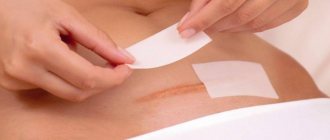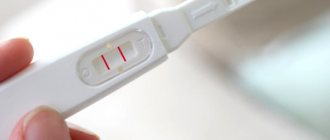With the advent of a baby, the life of a new mother can be significantly adjusted. All the time is devoted to the child and family, sleepless nights, walks, diapers, feeding, etc. - all this greatly tires a woman, and she simply does not have time to think about herself. And this is very important! After all, after delivery, the mother’s body especially needs care and attention. For example, a woman should consider contraception after giving birth to protect herself from an unplanned pregnancy.
As a rule, most couples, violating medical recommendations, resume intimate life earlier than the recommended period, but the likelihood of getting pregnant during this period is too high. That is why the issue of contraceptives must be resolved immediately after discharge from the hospital, and even better - during pregnancy.
Intrauterine device after childbirth
Such a contraceptive as the spiral appeared many centuries ago, but it became so firmly established that it has survived to this day, having been significantly transformed, but still performing its main function - protective. Today there are a huge number of spirals, they have different installation times and degrees of efficiency.
Why is the IUD most often placed after childbirth? There are several main reasons for this:
- Women who have given birth, as a rule, have a permanent partner and using barrier contraception in the form of a condom is not advisable: it is expensive and few people expect their husband to suffer from sexually transmitted diseases, from which it is worth protecting himself in this way.
- For those who do not have a child, the IUD is contraindicated - an ectopic pregnancy may occur, which, in turn, can lead to infertility.
To understand this issue, you should learn more about the spirals themselves. Today the number of their varieties has exceeded fifty. However, they are conditionally divided into 4 groups:
- Spirals made of inert materials.
For example, from polyethylene. This type of IUD is used today much less frequently than others, due to its low efficiency and high risk of prolapse from the uterus. - Copper coils
oxidize the uterine environment, which reduces sperm activity. The validity period of such a product is no more than 3 years due to wear and tear of the copper component. - IUDs with the addition of silver
are installed for up to 5 years . Their high efficiency and safety makes them quite popular among ladies.
- An intrauterine device with the hormones
progestogen or levonorgestrel, which are released daily into the uterine cavity. The advantages of these spirals are high efficiency, protection against inflammatory diseases and a service life of up to 7 years. However, their high price significantly reduces the number of people who want to install this particular type of protection.
Unfortunately, intrauterine devices have contraindications. You will not get an IUD if:
- You have a deformation of the uterine cavity, postpartum, inflammatory or acquired in some other way.
- Ladies who do not use condoms are not recommended to install such a product. The spiral significantly worsens the course of any sexually transmitted disease.
- Girls who have not given birth are denied installation of an IUD due to the risk of inflammation or ectopic pregnancy (which may well lead to infertility).
- During pregnancy, the IUD will also not be placed.
- Women planning to have a baby in the near future. After removing the IUD, the uterus will not be able to bear a fetus for some time (3-4 menstrual cycles).
- For women who have experienced a miscarriage, a good specialist will refuse to install an IUD.
In addition to these reasons for refusal, there are also contraindications for health reasons. Bleeding disorders, diseases and heart defects can also cause failure.
For women who are allergic to silver or copper, a hormonal type of IUD is recommended.
Progestogen IUDs will not be installed if you have:
- deep vein thrombosis
- breast cancer
- migraine
- cirrhosis of the liver
- hepatitis
Based on all of the above, the best IUDs are those that contain hormones, especially levonorgestrel. However, we note that the choice of the type of IUD is made with your doctor, after carefully studying the results of the preliminary examination.
Possible complications after administration
After childbirth, any manipulation in the uterine cavity can cause problems. What complications most often arise when inserting an IUD? Gynecologists in their practice after installing a contraceptive device recorded the following problems:
- Development of the inflammatory process. When there is a foreign body in the uterus, it is easier for bacteria to penetrate into its cavity, and as a result, a woman may develop chronic inflammation.
- Increased risk of ectopic pregnancy. The fertilized egg can become fixed in the fallopian tube. Such a complication can have life-threatening consequences for a woman.
- Loss of the IUD and the onset of unwanted pregnancy. If a woman has not noticed that her IUD has fallen out, she will not be protected in any other way.
- The appearance of malignant tumors. Studies have shown that the use of IUDs in some cases leads to the development of cancerous tumors of the female reproductive system.
If within two days after the intrauterine contraceptive was inserted, the pain does not disappear, and pathological bleeding is added to it, you will need to consult a doctor as soon as possible. All of the above complications are more typical for intrauterine devices with metals, in particular copper. Hormonal contraceptives usually do not cause such consequences.
READ ALSO: contraindications to the installation of an intrauterine device
For maximum safety and effectiveness of using an intrauterine device, it is necessary to choose not only a suitable contraceptive, but also a qualified specialist. An experienced doctor knows well when it is better to install a contraceptive after the birth of a child naturally or with a cesarean section; he will not make mistakes during installation and will give the patient recommendations that will help avoid any negative consequences of protection using an IUD.
When to place the IUD after childbirth?
Many women are interested in the question: how long after childbirth is the IUD inserted? The answer to this is determined in each specific case individually. But still, there are general rules for placing an IUD in the postpartum period.
If the baby was born by caesarean section, the IUD can be placed directly in the maternity hospital within 48 hours after birth. Otherwise you will have to wait approximately 5-8 weeks. Some doctors insist on waiting 6 months for the body to fully recover from stress.
But “natural” women in labor who are not breastfeeding will have to wait until their first period, and only a few doctors agree to install an IUD before this period. In this case, it is administered in the first week of the menstrual cycle. Breastfeeding mothers can receive an IUD several weeks after giving birth.
When and how is it installed?
Before the installation, which does not require a hospital stay for the patient, the gynecologist does all the necessary tests. As anesthesia, special painkillers are used to treat the cervix. The IUD is most often installed during menstruation, since it is during this period that the cervix is most widely opened, but this does not mean that a young mother should wait until the cycle is established. There are differing opinions regarding when the IUD can be placed after childbirth. You can hear that if a woman in labor wishes, the IUD can be easily installed almost in the maternity hospital itself. But most experts say that it is necessary to wait for the complete involution of the uterus, since the spiral may not just simply fall out, but also become a source of an additional inflammatory process. Therefore, the optimal installation period is the time required for the end of lochia. You should talk to your gynecologist about choosing contraception during your first visit upon discharge from the maternity hospital. It is usually recommended one to two months after birth. In this case, a mother who is breastfeeding a child should not wait for menstruation, since otherwise it is possible to complete that feeding without contraception while already deeply pregnant.
Installation of an intrauterine device
Installation of the spiral is carried out only by a qualified gynecologist. Before installation, they are usually sent for examination, tested for sexually transmitted diseases, and an ultrasound of the pelvis is performed.
The IUD is inserted in the first week of the menstrual cycle. This method is less painful. But when breastfeeding, the cycle has not yet recovered, so the installation is prescribed for any day.
After installation, it is recommended to abstain from sexual intercourse and heavy physical activity for at least a week. The next periods after installation may be longer and more abundant.
Removal of the IUD occurs only in a medical office by a specialist.
If, after inserting the IUD, you feel pain, discomfort in the lower abdomen, have a fever, or find spotting between menstrual cycles, immediately seek help from a doctor.
Is there a IUD for nulliparous women?
Photo: Girl at a gynecologist's appointment
In fact, in their practice, many gynecologists recommend and place an intrauterine device for nulliparous women, because this method of contraception is convenient, reliable, reversible and cost-effective. And, as practice has shown, complications do not always occur. The woman makes the choice, and the doctor is obliged to warn her about the possible risks.
One of the recommended IUDs is a hormonal intrauterine system called Mirena, which is reliable in terms of contraception and has therapeutic and prophylactic properties, destroying all barriers to the use of IUDs by nulliparous girls.
Important!
Mirena can only be given to nulliparous women who have one permanent partner and do not plan to have children in the near future.
The contraceptive effect of the Mirena hormone-releasing system lasts for 5 years. The reliability of the IUD is often compared to female sterilization, but unlike it, the contraceptive effect of the Mirena IUD is completely and quickly reversible. Fertility is restored on average 30 days after removal of the system.
WHO experts say that a nulliparous girl with ideal gynecological health and a complete examination can have a mini-device (a type of intrauterine device) with copper, silver or gold installed. But only under the following conditions:
- if this category of women cannot use other types of contraception;
- has one sexual partner;
- the likelihood of contracting sexually transmitted diseases is minimal;
- does not have chronic inflammatory processes of the pelvic organs.
Intrauterine device with silver
IUDs with silver have a high level of protection against unwanted pregnancies, and have the advantage of a long service life. In addition, silver has antiseptic properties, therefore it protects against inflammation. However, this effect is not as pronounced as with hormonal IUDs.
The relatively low cost of a silver spiral sets it apart from other types.
An alternative to silver in medicine was the use of gold. This metal in its pure form does not cause an allergic reaction; it is absolutely compatible with the human body. Although it is much more expensive than its copper and silver counterparts. IUDs made of silver and gold have no fundamental difference in design and operation, so the choice of such an acquisition depends entirely on the capabilities of your wallet.
T-shaped intrauterine device
The most common shape of the spiral is the anchor, or as it is also called, T-shaped. The basis of such a spiral is a polyethylene rod, on top of which a braid of copper, silver or gold is wound, and may also contain a reservoir for hormones. The arms of the anchor can be either straight or slightly curved.
The Mirena spiral, which has a reputation as the best and most expensive, is made in the shape of an anchor.
The advantage of this form will be its “stability” in the uterine cavity, its resistance to expulsion. One of the disadvantages is the danger of damage to the walls of the uterus or cervix during muscle contraction during menstruation.
As you can see, there are many types of spirals and they all have their advantages and disadvantages. In any case, the IUD will prevent the occurrence of unwanted pregnancy by 98-99%. And which IUD is best for you will be advised by your attending physician, who will take into account all important factors, such as the presence of underlying diseases, age, and hormonal levels.
When to apply protection
A number of cases when it is possible and necessary to insert an IUD after childbirth:
- women who need contraceptives during lactation;
- during abortions, without detection of infection;
- when hormonal drugs are contraindicated, as well as refusal to use them;
- in case of low risk of contracting a sexually transmitted infection.
Many young mothers ask the question: is it painful to insert an IUD immediately after childbirth? The procedure is painless. During insertion of the IUD, the woman feels slight discomfort. The procedure causes pain in the first two days, as during menstruation. Over time, the sensations pass.
When not to use
To answer the questions about whether it is dangerous to insert an IUD after the first birth and in what cases it is prohibited, you should find out in detail the features of the contraceptive, indications for use and possible complications. Also find out why there is a smell from the vagina after childbirth and how to reduce the temperature during breastfeeding.
Using this method is the best protection option for most women. The IUD does not affect a woman’s hormonal levels and does not lead to physiological changes.
There are a number of cases in which the IUD is contraindicated. These include:
- detection of benign/malignant tumor;
- pathologies in the development of the genital organs;
- pregnancy;
- uterine bleeding for an unknown reason;
- oncology;
- acute form of hepatitis;
- cirrhosis of the liver;
- allergy;
- intolerance.
It is not recommended to use an IUD in case of early ectopic pregnancy or bleeding disorders. In all other cases, the question is: is it possible to insert an intrauterine device immediately after the first birth? The answer is yes.
Before using a contraceptive, it is better to discuss the issue in detail with a gynecologist, carefully weigh the advantages and disadvantages, and be examined by a doctor. Only a gynecologist has the right to decide whether a hormonal or metal-containing contraceptive can be placed.
Which option should I choose?
Most women cannot decide which of the available IUDs is best to place after childbirth? There are a large number of contraceptive options. The most popular include the following.
- Multiloud Cu-375. A common copper-containing drug. May be used for no more than five years.
- Juno Bio. Can be used for up to eight years. Domestic made naval forces. The composition contains copper and silver.
- Eurogine. Contains silver and gold ions. Protect the genitals from the development of infection. Applicable for up to five years.
- Mirena. Combines the functions of an IUD and hormonal drugs. Does not affect body weight. Allowed for use during lactation. Has an efficiency of 99.9%. Established for a period of five years. With this contraceptive, ovulation is maintained.
Video: Spiral after childbirth
Not every woman wants to get pregnant again soon after giving birth. Therefore, the issue of contraception when there is a baby in your arms is very relevant. Look around, you will see a lot of mothers with children of the same age. Many of them will tell you that their plans did not include such a rapid addition to the family. But this is what happened: despite breastfeeding, the use of oral contraceptives, strict calculations.
We do not mean to say that birth control pills are not effective, condoms are weak, and breastfeeding does not protect against pregnancy. It’s just that every rule has exceptions, and any woman can make a mistake in the calculations while taking care of the house and baby.
So, let's talk about the most reliable of the modern methods of contraception - the intrauterine device, when you can install the device after childbirth, what are its advantages, disadvantages, what you should pay attention to.
What is this
Modern medicine offers many methods of contraception, which have their own positive and negative effects. For each woman, the most suitable type of protection will be different, since everyone has their own body and diseases.
Ladies with premenstrual syndrome, diseases of the thyroid gland and adrenal glands, as well as those who have problems conceiving, are not suitable for oral contraceptives. You can simply forget to take the drug, and problems with menstruation will begin. The best option for all mothers is to insert an intrauterine device (IUD).
An intrauterine device after childbirth is one of the most effective and safest ways to control birth rates.
But only a doctor can help you choose a truly reliable and safe method of contraception.
IUD: what is it, what are the advantages and disadvantages?
The IUD or Intrauterine Device is a mechanical means of protection against unplanned pregnancy. It is installed directly into the uterine cavity and allows a woman, without any additional means of contraception, to quietly engage in sexual activity without becoming pregnant. This is in simple terms.
What are the advantages of this method of contraception? One of the main and most convenient is constant protection. That is, with an IUD installed, you do not need to keep a calendar, take pills strictly on schedule and, thus, there is simply nothing to forget.
Another plus is that the spiral is installed for a long time, or more precisely, for several years. It is during this period that you can absolutely not worry about safety (provided that the IUD is installed correctly). The advantage of this method is its relative cost-effectiveness. At first glance, it may seem that this little thing is quite expensive. However, its price is approximately equal to the cost of an annual set of hormonal pills. Annual! While it is established for a period of up to 5 years.
Gestational diabetes mellitus - causes, symptoms and other useful information
If you insert an IUD after childbirth, it does not affect the quality and taste of breast milk, and has no effect on the baby’s body if breastfeeding.
And the spiral will come in handy if for some reason hormonal oral contraceptives are contraindicated for you or, say, you have varicose veins, which is quite common today.
The IUD is removed when you need it and the ability to get pregnant after it is restored quite quickly.
The guarantee of not getting pregnant in this case is 99.9%.
Operating principle and types of spirals
An intrauterine device (IUD) is a small, flexible device that is inserted into the uterus to prevent pregnancy. The most commonly used are T-shaped spirals, but there are also ring-shaped devices.
The operating principle of the IUD is determined by its type
:
- non-medicated IUDs, made of plastic with the addition of metal, simply prevent the fertilized egg from attaching to the uterine mucosa (they are practically not used today);
- medicinal, that is, containing copper ions or the hormone progestin, in addition to creating a physical barrier, also affect sperm motility, ovulation, the structure of the endometrium and the thickness of the ecclesiastical mucus.
Regardless of the type, this contraceptive has absolutely no effect on lactation. Therefore, if a nursing mother decides to put in an IUD after childbirth, then it is absolutely safe for the child.
Disadvantages, disadvantages, contraindications for installing an IUD
You should not install an intrauterine device if you had inflammatory diseases of the genital organs before or after childbirth. Here you should wait for complete recovery and tissue regeneration. The IUD is inserted and removed only by a doctor. This is the only way you can provide yourself with the desired guarantees of safety and avoid complications later.
The spiral tendrils can sometimes cause some discomfort (often microtrauma) to your sexual partner. Therefore, when installing, you can ask the doctor to make them a little shorter.
After each menstruation, you should check the presence of the antennae, making sure that the spiral remains in place.
Since your body will perceive the IMF as a foreign body, the uterus will try to “expel” it, contracting and giving you unpleasant sensations in the lower abdomen. This can also cause heavier and more painful periods.
If you decide to have an IUD after childbirth, you should be aware that there are certain contraindications.
These include neoplasms (both malignant and benign), pathologies of the uterus, cervix, pregnancy, inflammatory processes, ischemia, uterine bleeding, etc.
There are special contraindications for coils that contain copper: an allergy to this metal. Women suffering from coronary heart disease, migraines, thrombosis, and cirrhosis of the liver are not advised to install a hormonal IUD.
What to do when the internal or external seam breaks after childbirth
What is a spiral?
This is a specially shaped device that is inserted into the uterine cavity and affects its endometrium. Being a foreign body, the spiral contributes to a change in the internal environment in the uterus, due to which sperm do not reach their goal, losing activity. The shape of the spiral can be different, as well as the size, so it is best to select it with a gynecologist, and not on your own. The latter is also possible, since spirals are sold in pharmacies, along with other contraceptives. Statistics show that the effectiveness of this method of contraception is 99%. These are quite high numbers, especially considering that a 100% method of contraception has not yet been invented, so the likelihood of getting pregnant is present with each of them. According to their type, spirals are divided into:
- medications that contain copper ions or hormonal drugs;
- non-medicinal, the principle of action of which is to prevent the attachment of a fertilized egg. This type is considered obsolete and is practically not used.
What types of IUDs are there, and why are they placed?
Spirals come in regular and medicated forms.
Conventional ones are made from silver, platinum, gold and polyethylene and are installed solely for the purpose of preventing pregnancy.
Medicines are often given to women, among other things, for therapeutic effects, for example, to treat or control uterine fibroids. They contain copper or the hormone progesterone.
It should be noted that the IUD itself is not a barrier to fertilization of the egg. It is quite possible. However, the IUD thus affects the inner layer of the uterus; the fertilized egg cannot attach to it.
Regular coils need to be removed after a year. IUDs containing copper - after 3-5 years at the discretion of the doctor, and hormonal (with progesterone) - after 5 years (unless, of course, you want to get pregnant earlier).
Types of spirals
Intrauterine devices are a popular and effective means of contraception for women who have given birth. They differ in form, content of active substances, duration of use and other parameters.
By shape
In general, the IUDs are structured in approximately the same way. The elements are as follows:
- The main part is made of synthetic material, often with trace elements added to improve efficiency.
- Antennae are kind of conductors. Designed for subsequent removal of the spiral by pulling on it.
The spiral should be selected individually. Distinguished by their shape (appearance), they will stand differently in the uterine cavity.
There are the following types of IUDs:
- T-shaped,
- round,
- serpentine,
- like the letter “S” - Lipps loop,
- in the form of an umbrella and others.
Shapes of intrauterine devices
By composition
Various compounds are often added to the composition to enhance the contraceptive effect, bactericidal and others. Based on this, there are the following types:
- without additives,
- with copper,
- with silver,
- with gold
- with hormones.
We recommend reading the article on how to avoid getting pregnant after childbirth. From it you will learn about natural birth control, the use of hormonal contraceptives, intrauterine devices and other devices.
And here is more information about when you can get pregnant after childbirth.
By wearing period
The average duration of use of spirals is from 3 - 4 to 5 - 7 years. In this case, only regular examinations by doctors are required, and the product itself is installed once. It is not recommended to exceed the deadlines. This is fraught with the growth of the spiral into the thickness of the uterus (especially S-shaped and serpentine), as well as the development of the inflammatory process with all the ensuing complications.
According to its action
The main effect of the spiral is to prevent the fertilization process, as well as, to some extent, the implantation of the fertilized egg. If the composition includes copper, it has an additional spermicidal effect, immobilizing male reproductive cells.
The addition of silver adds anti-inflammatory and bactericidal effects to the spiral. At the same time, it has a detrimental effect on sperm.
IUDs containing gold have the main advantage that it is an absolutely inert metal. There is no allergy or any other type of intolerance to it. Gold is not subject to corrosion, so the service life of such spirals is somewhat longer.
Hormonal intrauterine devices should be highlighted separately. The most popular model is Mirena. It has a T-shape and a small container for the main active ingredient - levonorgestrel. These are the most expensive products and provide a therapeutic and contraceptive effect for a period of 5 years.
It is prescribed primarily to women with some gynecological diseases: heavy menstruation, fibroids, endometriosis, endometrial hyperplasia and others.
Is it painful to insert the IUD?
In principle, inserting a spiral does not hurt. It is least painful to install it during menstruation - from 1 to 7 days. However, you may still experience discomfort, as with any gynecological examination. Some women feel nothing at all, while others may experience a slight tugging in the lower abdomen (as during menstruation). As a rule, this goes away within a few hours. Sometimes faster, sometimes a little longer.
The gynecologist will advise you to abstain from sexual activity for the first few days. And before the onset of your period, still use a barrier method of contraception (in other words, a condom).
Immediately after your period, you should come for a follow-up examination and check whether the IUD in the uterus is working properly. If the doctor said that everything is “OK”, you no longer need to use additional means of protection.
Preparation for the procedure, installation and removal of the spiral
Preparation for the introduction of intrauterine contraception includes a bimanual examination and ultrasound of the pelvic organs. Thanks to these diagnostic methods, the topography, size of the uterus and the distance between the angles are determined. In addition, it is necessary to examine the degree of cleanliness of the vagina and cervical canal secretions so that when an IUD is installed, an infectious process does not develop in the uterus.
Immediately before the procedure, the woman must observe sexual rest for 2-3 days. You should not douche or use intravaginal medications - tablets, suppositories or creams. A few days before the procedure, you will have to stop using intimate hygiene products.
IUD installation:
- The specialist examines with mirrors and measures the length of the uterine cavity with a special probe.
- The doctor treats the cervix with an antiseptic solution and holds it with bullet forceps.
- A sterile guidewire is inserted to the appropriate depth, inside which the IUD is placed.
- After installation, the conductor is removed, and the spiral remains in the uterine cavity.
- The doctor trims the “antennae” a short distance from the entrance to the cervix. The threads protrude into the vagina no more than 2-3 cm and do not cause discomfort during sexual intercourse.
- Finally, an ultrasound is performed to check the correct position of the contraceptive device.
Removing the spiral:
The doctor grabs the protruding “antennae” and gently pulls on them. After removal, a control ultrasound and a bacteriological smear from the vagina are usually prescribed. The procedure is carried out quickly, and the woman does not experience severe pain.
When can IUD be inserted after the baby is born?
There are different opinions on this matter. Some gynecologists place the IUD after childbirth right in the maternity hospital. This is only possible if the woman does not experience any inflammatory processes before and after the birth of the child.
Is it possible to put an IUD in women after a caesarean section?
Is this advisable or not? Probably, the body still needs rest. After giving birth, you will still be advised to abstain from sexual activity for a while to avoid unnecessary risks of infection. Therefore, if you are very worried and are afraid of becoming a mother again too soon, you can give your internal organs a certain time to recover and have an IUD placed after giving birth in a month and a half.
If the lactation process proceeds without problems, then you can wait six months to install the IUD. However, before inserting the IUD, you should still use a condom during sexual intercourse, since there is still a risk of getting pregnant.
Minuses
But still, the IUD is not a panacea; its functions are limited to the destruction of sperm. Some women may experience pain in the lower abdomen or lower back after installing the device. In addition, periods may become more heavy and painful. And in the first 10-15 days, the mechanism can provoke minor bleeding.
This type of protection does not protect against sexually transmitted infections at all.
Moreover, if this device is located in the uterus, then it seems to open it slightly, thereby increasing the likelihood of harmful bacteria entering the body. If you become infected with sexually transmitted diseases while wearing it, the disease will manifest itself in a more complex form. In addition, there are cases when the contraceptive itself fell out of the uterus.
Read also Problems and quarrels with your husband after the birth of a child. Why and what to do?
Is it possible to remove the spiral yourself?
We will definitely answer no to this question. The risk of complications (bleeding, infectious diseases, etc.) is too high. Therefore, be wise: do not consider it difficult to see a doctor.
With the advent of a baby, the life of a new mother can be significantly adjusted. All the time is devoted to the child and family, sleepless nights, walks, diapers, feeding, etc. - all this greatly tires a woman, and she simply does not have time to think about herself. And this is very important! After all, after delivery, the mother’s body especially needs care and attention. For example, a woman should consider contraception after giving birth to protect herself from an unplanned pregnancy.
As a rule, most couples, violating medical recommendations, resume intimate life earlier than the recommended period, but the likelihood of getting pregnant during this period is too high. That is why the issue of contraceptives must be resolved immediately after discharge from the hospital, and even better - during pregnancy.
Contraindications
Despite its advantages, the spiral is not allowed to be used by all women after childbirth. The main absolute contraindications are:
- The period of pregnancy or even suspicion of its occurrence.
- Oncological processes of the genitals.
- Having promiscuous sex life due to the risk of contracting STDs.
- Vaginal bleeding of unknown origin.
- Chronic inflammatory diseases of the reproductive system in the acute stage or during the period of exacerbation.
Methods of protection against unplanned pregnancy after childbirth
It is, of course, advisable to discuss the issue of contraceptive methods with your doctor while you are pregnant. If for some reason this did not happen, do not worry, because you can discuss this topic with the doctor at the maternity hospital. In any case, you cannot do without consulting a gynecologist. By choosing contraceptives on your own during breastfeeding, you risk not only your health, but also that of your baby. After all, many of them can negatively affect lactation and, accordingly, the well-being of the baby.
During lactation, a woman is allowed to use the following methods of contraception:
- Barrier, that is, the use of condoms.
A classic method of protection against unplanned pregnancy, however, if used incorrectly, it does not provide a 100% guarantee. - Oral (taking hormonal drugs)
- prescribed exclusively by a specialist, since not all of the existing drugs are approved during pregnancy. - Insertion of an intrauterine device
is the most popular method after delivery. The main advantages of the IUD are safety and long-lasting results (up to 5 years).
Which IUD is better to place after childbirth?
Today there is a wide range of gynecological devices. They differ in quality, shape, composition. The choice largely depends on the cost and, of course, the individual characteristics of the female body.
The rod of the IUD contains active substances, which provide protection against unplanned pregnancy, and thanks to its shape (T-shaped, ring-shaped, etc.), the contraceptive device is held inside the uterine cavity.
So, there are two main types of spirals:
- non-medicinal
- made of polyethylene and contain metal (platinum, silver, etc.); - medicinal
(contain copper ions and progesterone) - in addition to the contraceptive effect, they have a positive effect on the ovulatory period, the structure of the endometrium, etc. In addition, such devices are less likely to cause complications and are better fixed in the uterine cavity. However, there is also a minus. Due to the rapid depletion of active components, they must be replaced after 1-3 years.
It is unrealistic to choose the most optimal type of spiral without consulting a doctor. Therefore, if you decide to think about this type of contraception, be sure to consult a gynecologist. Having studied your medical history, the specialist will be able to select the most effective and reliable type of gynecological device.
General information about the IUD
Installation of the spiral is carried out only in a medical institution after tests and examination of the patient by a gynecologist and is recommended for women who have given birth without any identified infectious and inflammatory diseases of the genitourinary area.
The device is installed for a period of 3-5 years on the third or fourth day from the beginning of menstruation, which theoretically excludes the woman from becoming pregnant. Sexual activity is allowed 8-10 days after its administration.
To eliminate the risks of possible complications, before inserting an IUD, the doctor prescribes the following tests to the woman:
- Bacteriological analysis of cervical and vaginal smears;
- General analysis of urine and blood;
- Screening for sexually transmitted infections (hepatitis B and C, syphilis, HIV);
- Ultrasound of the pelvic organs.
Installation of the spiral is possible only if there is I and II degree of cleanliness of the vaginal sphere. If an infectious-inflammatory disease is detected, the gynecologist prescribes an in-depth study and carries out antimicrobial treatment. Before introducing a contraceptive, a 6-month break is required for complete recovery in order to prevent the disease from becoming chronic.
The question “is it possible to install a spiral” can only be answered by a specialist during an individual consultation. Women with a history of childbirth and several abortions should approach the IUD installation procedure with caution, since in some cases (1%) the IUD can cause perforation (perforation) of the uterine walls.
Many women are interested in whether it is possible to insert an IUD after childbirth to reduce the risks of another pregnancy? Experts answer unequivocally: “it’s possible.” The IUD can be inserted 2-3 months after birth after examination by a gynecologist. If a woman plans to become pregnant, fertilization is possible already in the first month after removal of the IUD by a specialist.
The opinions of gynecologists on this issue differ: some are sure that it is impossible, other experts say that it is possible, but only if all the necessary studies are carried out. But doctors agree on one point: even the most professional installation of the IUD can cause unwanted complications for women’s health.
Adverse reactions associated with IUD implantation are most often observed in patients with chronic pelvic inflammatory diseases, irregular menstruation, as well as in nulliparous women, which allows us to partially answer the question “can an IUD be inserted into nulliparous women.”
When an intrauterine contraceptive is inserted, uterine bleeding may occur and, less commonly, damage to the cervix. During the process of contraception, a certain percentage of women complain about:
- Nagging pain in the lower abdomen;
- Menometrorrhagia (bloody discharge), which, against the background of heavy bleeding when receiving drug treatment, is an indication for removal of the coil;
- Inflammatory diseases of the pelvic organs. Inflammatory reactions with IUDs occur in approximately 4-15% of cases and can manifest themselves in the form of endometritis, cervicitis, pelvioperitonitis, and pelvic abscess. When they become chronic, these diseases can provoke disruption of reproductive function and lead to infertility, which can become a serious psychological trauma for a nulliparous woman.
Installation of an intrauterine device, as mentioned above, increases the risk of inflammatory diseases of the pelvic organs (due to the fact that the cervix is always slightly open), the onset of an ectopic pregnancy and thins the endometrial layer in the uterus, which can negatively affect the development of the desired pregnancy, increasing the risk of miscarriage.
So, is it possible to insert the IUD into nulliparous women? In fact, it is possible, and in the work of gynecologists this practice is widespread. However, girls who are just going to become mothers in the future are recommended to use alternative means of protection: condoms, oral contraceptives, suppositories, etc.
Features of IUD installation
An intrauterine device is installed or removed only in a clinical setting and only by a gynecologist. Before diagnosis, the patient must undergo examination and tests. Only in the absence of contraindications will the doctor be able to determine the date for inserting the IUD. The procedure is usually performed during menstruation. But since the cycle has not yet been fully restored in new mothers, the installation can be carried out at any time. If the birth took place without complications, then this can happen as early as 6-7 weeks from the moment the baby is born. Otherwise (for example, with a caesarean section), the procedure will have to be postponed for six months.
Installation of the IUD is quick and virtually painless. The shelf life of a gynecological device depends on the quality of manufacture; it can be a year, or maybe eight years. But this does not mean that the spiral needs to be worn as long as indicated in the instructions. If desired, it can be removed ahead of schedule.
In the first days after the procedure, the doctor will definitely recommend abstaining from sexual intercourse and avoiding physical activity, as well as not using tampons and refusing to visit the bathhouse or sauna. In the future, the IUD will not cause discomfort, and the woman can safely return to her usual lifestyle. However, after 10 days, and then again 6 weeks after installation, you must see a doctor to make sure that the spiral is attached correctly and there are no complications. In the future, visits to the doctor should be made regularly - twice a year. However, if alarming symptoms arise (menstruation irregularities, lower abdominal pain, fever, or the IUD threads cannot be felt), immediately go to the gynecologist.
Contraindications to the IUD
The IUD for nulliparous women is absolutely contraindicated in the following conditions:
- suspicion of cancer of the cervix and uterus;
- ectopic pregnancy in the past;
- abnormal structure of the uterus;
- frequent inflammation of the genital organs;
- heavy, prolonged, painful menstruation;
- severe anemia;
- uterine fibroids;
- allergy to metal.
Alternative methods of contraception for young nulliparous women are condoms, hormonal contraceptive pills, and suppositories.
If you are a young nulliparous girl who has decided, then follow the following rules:
- the first week after insertion of the intrauterine device, abstain from sexual activity;
- avoid heavy physical activity;
- after each menstruation, check the IUD threads in order to notice the displacement or loss of the contraceptive in time;
- pay attention to the appearance of the first signs of inflammation (fever, heavy discharge with an odor, discomfort or pain in the lower abdomen);
- undergo a pelvic ultrasound every 6 months;
- visit your gynecologist regularly;
- do not change sexual partners - this increases the risk of inflammation.
Remember!
If inflammation of the uterus begins, the coil must be removed.
If you have no complaints, you feel well, and comply with all conditions, continue to use the IUD for 5 years or as long as necessary. In this case, the intrauterine device will not harm you.
Pros and cons of the IUD
Having discussed the types of IUDs and the principle of their installation, one cannot help but recall the positive and negative aspects of this method. The advantages of the IUD are:
- safety during lactation;
- long shelf life;
- 99% contraceptive effect;
- do not disrupt normal life;
- devices containing progesterone reduce pain and shorten the duration of monthly discharge;
- availability.
The disadvantages of the IUD include:
- discomfort and bleeding for the first two weeks after installation;
- long and heavy periods in the first three months after the procedure;
- the device provides a contraceptive result, but does not protect against infections;
- after the installation of the spiral, sudden changes in mood, skin reactions and decreased sexual desire may be observed.
Despite all the shortcomings, intrauterine devices are considered the most effective and safe method of contraception during the postpartum period. However, do not forget that the effectiveness of their action depends not only on the professionalism of the doctor, but also on an attentive attitude to your health.
Despite the many concerns after the birth of a child, sooner or later the question of preventing an unplanned pregnancy still arises.
It is clear that other intravaginal devices are excluded; condoms are not suitable for everyone.
What remains is the IUD, which is one of the best means of preventing pregnancy.
Is it possible to install an IUD after childbirth? This is a common dilemma that a nursing mother must decide for herself.
According to statistics, 95% of women resume sexual activity after childbirth in approximately two months. This is necessary for the final restoration of the female body and the cessation of all discharge.
The intrauterine device is the most common contraceptive device.
It is located in the uterine cavity and creates a barrier to the implantation of the fertilized egg. If used correctly, the effectiveness of intrauterine contraception approaches 100%. In this way, the use of the spiral is comparable to the effect of oral contraceptives.
Like any medical device and method, the spiral has its advantages and disadvantages.
Contraindications and possible side effects
When you decide to insert an intrauterine device after childbirth, you should consult a doctor and find out if there are any contraindications. If at least one of the following conditions is present, the use of this method of contraception should be discontinued:
- inflammation of the inner part of the uterine wall - endometritis,
- scars or growths on the cervix,
- benign or malignant neoplasms in the uterine cavity,
- congenital malformations of the genital organs,
- bleeding from the uterus, the nature of which is not established,
- severe pathologies of the heart and blood vessels,
- liver diseases that lead to liver failure.
Warning! Polyps in the uterus are one of the contraindications.
When a woman has an IUD inserted after childbirth, there is a possibility of its falling out, or, in scientific terms, expulsion. Fortunately, this doesn't happen often. The probability of sudden expulsion is 7 – 15%.
When installing an IUD after childbirth, you need to remember the possible occurrence of the following side effects:
- acute and chronic inflammation in the uterus due to bacteria,
- significant blood loss and anemic syndrome due to heavy menstruation,
- development of neoplasms in the cervix,
- ectopic, most often tubal, pregnancy, which occurs due to the fact that the fertilized egg cannot attach to the uterine cavity, but nothing prevents it from implanting in the fallopian tube.
The photo shows cervicitis (inflammation of the cervix), as one of the complications when using the IUD.
Important! Placing an IUD during pregnancy is strictly prohibited, as this disrupts the development of the child in the womb.
IUD after childbirth - is it possible to use it?
Is it possible to install an IUD after childbirth? This question often arises during pregnancy.
Inserting the IUD into nulliparous women is very difficult due to the tightly closed cervix of the uterus and the narrow cervical canal. The IUD after childbirth, as stated above, is the most effective existing method of contraception.
The advantages of using the IUD after childbirth include:
1. High, almost 100% effectiveness of this method, comparable to the result from the use of oral contraceptives. There is no need for additional effort: taking tablet medications requires constant monitoring; even one missed tablet can lead to pregnancy.
2. A regular IUD does not change hormonal levels, as happens when taking tablet contraceptives, and, therefore, does not change ovulation. Therefore, after removing the IUD, there are no problems with a planned pregnancy in the near future. True, there are hormone-containing IUDs, after the use of which the restoration of fertility occurs in approximately the same time as when taking tableted hormonal contraceptives.
3. Does not interfere with lactation.
4. The IUD maintains contraceptive functions continuously, including the period of menstruation.
5. Duration of contraception from 5 to 10 years.
6. Does not cause discomfort to any of the sexual partners.
7. Affordability and ease of installation.
These advantages of the IUD over other methods of contraception answer the doubts of some women about whether the IUD can be inserted after childbirth.
8. It is possible and even convenient, since modern spirals contain silver and gold components, the presence of which suggests an anti-inflammatory effect.
9. The IUD is a good alternative for many women after childbirth with existing contraindications to taking tablet contraceptives.
10. In addition, which is very important for a woman after childbirth, intrauterine contraception does not cause metabolic disorders, unlike oral contraceptives. This is another weighty argument and answer to the question: “Is it possible to insert an IUD after childbirth?”
11. The economic aspect is also important. One package of contraceptives costs less than the IUD. But an oral contraceptive will have to be purchased monthly, unlike an intrauterine device, which will be used for many years (at least up to five).
Removal of the IUD
After the contraceptive expires, it must be removed. Just like the insertion procedure, the removal procedure of the device is painless. If the patient does not experience any complications, a new device can be inserted immediately.
We looked at one of the best methods of birth control for women after childbirth. Of course, only you can decide which one is best for you after a preliminary consultation with your doctor. But before you make a choice in favor of one method or another, carefully weigh the pros and cons, because the consequences of their use may be irreversible.
If you choose such contraception for yourself, do not forget about personal hygiene. In most cases, basic self-care prevents possible complications.
IUD after childbirth - disadvantages of the method and contraindications
There are also some disadvantages of using a spiral that you need to know about:
1. Does not prevent the penetration of pathogenic microbes that cause sexually transmitted diseases.
2. It is an abortifacient.
3. It should be installed only by a specialist to avoid complications. These include painful spasms, heavy and long menstrual and intermenstrual bleeding, and various inflammations.
4. Under certain conditions, if a woman ignores the specialist’s recommendations, the IUD can leave the uterine cavity on its own. The incidence of coil loss (expulsion) is low, but it is important to be aware of this possibility. Only a specialist can insert and remove an existing intrauterine device. Every woman can control it, following the advice of a doctor.
Despite the positive aspects of the intrauterine device, there are contraindications to its installation. The doctor will warn you about them during the examination and when deciding on the choice of contraceptives. Such contraindications are:
1. Uterine fibroids.
2. Pathological structure of the uterus, in which it is impossible to place a spiral in its cavity.
3. Frequent inflammation of the genitourinary organs.
4. Painful, heavy and prolonged menstruation.
5. With a history of uterine bleeding.
Is an IUD placed in nulliparous women?
Is the IUD indicated for nulliparous girls? Until now, doctors have not come to a consensus on this issue. Some of them are categorical and argue that it is impossible, others are inclined to believe that it is possible, but only after a complete examination and assessment of all the pros and cons.
So, why do most experts believe that the IUD is not recommended for nulliparous girls? This is due to the negative consequences that can affect the reproductive health of a nulliparous woman and deprive her of the joy of motherhood.
- Installation of an intrauterine device has a traumatic effect on the cervix and cervical canal. This can lead to dysfunction of the cervix and the appearance of isthmic-cervical insufficiency (ICI) in the future. ICI is a common cause of miscarriage and premature birth. There is a risk of subsequent problems with pregnancy!
- It is believed that in nulliparous women the incidence of spontaneous loss of the device (expulsion) is high. This complication is associated with the small size of the uterine cavity in nulliparous women.
- Most often, nulliparous women are young girls whose sex life is still irregular and whose sexual partners often change. Such women are at increased risk for the development of inflammatory processes and sexually transmitted diseases.
- The intrauterine device does not protect against sexually transmitted infections. And, in addition, it can cause inflammatory diseases of the uterus and appendages.
- The use of an IUD increases the risk of ectopic pregnancy.
- Inflammation due to the IUD leads to the development of adhesions in the fallopian tubes.
- There is a possibility of tubal infertility.
- Although small, there is a possibility of a puncture of the uterus (perforation) when inserting the IUD. This complication can lead to surgery, and in severe cases even removal of the uterus.
Take Our Poll









